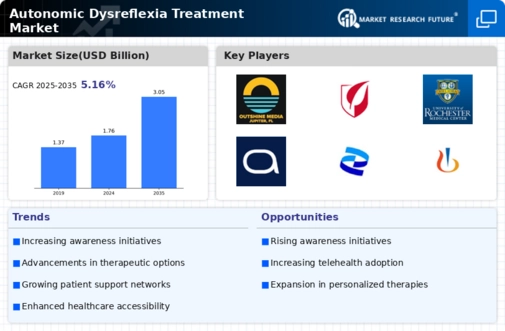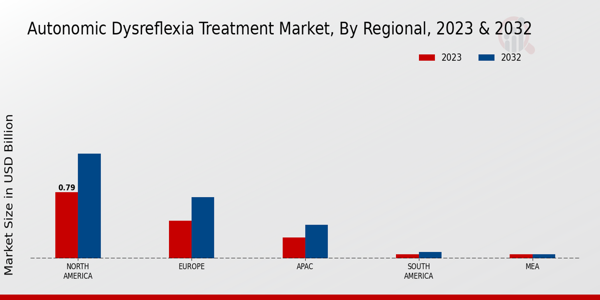Market Growth Projections
The Global Autonomic Dysreflexia Treatment Market Industry is projected to experience substantial growth over the coming years. With a market value expected to reach 1.76 USD Billion in 2024, the industry is poised for expansion. The compound annual growth rate of 5.12% from 2025 to 2035 indicates a robust trajectory, driven by factors such as technological advancements, increased awareness, and a growing geriatric population. As the market evolves, stakeholders are likely to focus on innovative treatment solutions and improved patient outcomes, positioning the industry for continued success.
Growing Geriatric Population
The aging population is a significant driver of the Global Autonomic Dysreflexia Treatment Market Industry. As individuals age, they are more susceptible to conditions that may lead to autonomic dysreflexia, such as spinal cord injuries and other neurological disorders. The World Health Organization estimates that the global population aged 60 years and older will reach 2.1 billion by 2050. This demographic shift is likely to increase the demand for effective treatment options, as older adults often require specialized care. Consequently, the market is poised for growth, with a projected value of 1.76 USD Billion in 2024, reflecting the urgent need for tailored treatment solutions.
Regulatory Support and Funding
Regulatory support and funding initiatives are essential for the advancement of the Global Autonomic Dysreflexia Treatment Market Industry. Governments and health organizations are increasingly recognizing the importance of research and development in this field. Funding for clinical trials and innovative treatment approaches is on the rise, which may lead to the introduction of new therapies and improved patient care. This supportive environment is likely to foster innovation and drive market growth, contributing to the anticipated increase in market value to 3.05 USD Billion by 2035.
Increased Awareness and Education
Raising awareness about autonomic dysreflexia among healthcare professionals and patients is crucial for the Global Autonomic Dysreflexia Treatment Market Industry. Educational initiatives and training programs are being implemented to ensure that medical staff can recognize and manage this condition effectively. Increased awareness leads to earlier diagnosis and treatment, which can significantly improve patient outcomes. As healthcare systems prioritize education and training, the market is expected to benefit from a growing number of diagnosed cases, ultimately contributing to the projected market growth to 3.05 USD Billion by 2035.
Advancements in Medical Technology
Technological advancements are playing a pivotal role in shaping the Global Autonomic Dysreflexia Treatment Market Industry. Innovations in medical devices and treatment methodologies are enhancing the management of autonomic dysreflexia. For instance, the development of advanced monitoring systems and non-invasive treatment options is improving patient outcomes. Furthermore, the integration of telemedicine and digital health solutions is facilitating better access to care for patients worldwide. As these technologies evolve, they are likely to drive market growth, with an anticipated compound annual growth rate of 5.12% from 2025 to 2035, reflecting the industry's commitment to improving treatment efficacy.
Rising Prevalence of Spinal Cord Injuries
The Global Autonomic Dysreflexia Treatment Market Industry is experiencing growth due to the increasing incidence of spinal cord injuries, which are a primary cause of autonomic dysreflexia. According to health statistics, the prevalence of spinal cord injuries is estimated to affect approximately 54 individuals per million people annually. As the global population ages and the incidence of traumatic injuries rises, the demand for effective treatment options is likely to increase. This trend is expected to contribute significantly to the market, with projections indicating a market value of 1.76 USD Billion in 2024, highlighting the urgent need for innovative therapies and interventions.













